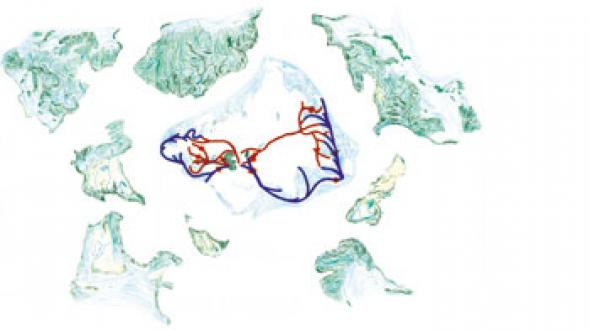H2EARTH
Ocean Earth Development Corporation was established in 1980, emerging from the New York-based Offices, founded by Peter Fend, Colen Fitzgibbon, Jenny Holzer, Peter Nadin, Richard Prince and Robin Winters. Ocean Earth was specifically conceived as an instrument for implementing the goals of the environmental art movement, building upon the ideas of artists such as Robert Smithson, Dennis Oppenheim and Gordon Matta-Clark (with whom Peter Fend worked closely until his death in 1978). The organisation has no fixed membership but functions as a loose association of artists, architects and scientists, shifting according to the needs of each project as they take place around the world (although Fend has been a central figure throughout). Through intensive inter-disciplinary collaborations, connecting ecological imperatives with future-oriented technology, Ocean Earth has sought to develop a wide range of strategies for improving our relationship to the environment.
As part of Mute’s art issue, Peter Fend has devised a ten page feature in which the West’s War on Terror is examined in relation to Central Asia’s precious oil reserves, and a radical ’earth work’ – essentially an ecological rescue package for the planet – is presented.
EURASIA
Today’s world is run by the mineral industries, especially petroleum. Consequently, the world suffers global warming, acid rain, local air pollution, sea-level rise, aberrations in climate, leading to drought and, conversely, floods. The human race has always faced a collision with Nature. Now, as a prelude to that showdown, we’re having a dispute over global leadership. The Caspian Sea appears to be the last big petroleum prize, vital to controlling most of the world population. ExxonMobil have published an op-ed piece which states that control of the ‘Asia-Pacific’ and South Asian populations will come with their provision of what it calls ‘fuel for growth’. Competing for the contracts and control of ‘fuel for growth’ provision - the pipelines, the ports, the refineries and their locations – are Argentina (backed by Spain and Germany), the US (with companies personally linked to Bush and Cheney), the UK/Netherlands (whose jointly owned Shell is building a colossal refinery in Hong Kong, the biggest single investment in China, to receive the ocean-shipped petroleum), China (which ejected the British-Dutch consortium building the giant port for transhipment via Afghanistan, four days after September 11), and Russia (which, of course, opposes terrorism and is busy installing its troops in Kabul thus pre-empting the Brits and numerous other countries). Little has been said as yet about how petroleum isn’t desirable at all, and that it needs replacing.
But with war comes change, presenting the new thinking and new visions embodied in art with an opportunity. Could a post-war art and architecture change the world, so bringing it more into line with nature? If art is ‘that by which nature makes more nature’, then why not have art reconcile our civilization with nature?
It has happened before. In 17th century France, a painter became the chief military engineer, the Pentagon boss, for the king. In the 16th century, Florence’s victory over arch-rival Pisa was secured with river diversions designed by da Vinci. In 19th century USA, the art-star painter S.B. Morse invented a technology most needed by the army in its fight against the South, and later, the American Indians: the telegraph. What of 21st century Eurasia?
Given the conundrum of wars over discredited industries (like oil) using soon-to-be-obsolete technologies like aircraft carriers, art can weigh in with more natural paradigms (one cannot say ‘new’, because all the technologies and all the artworks have ‘been around’, largely unnoticed by those in power.) Given what became of Russian Constructivsm, or Italian Futurism, or the new world envisioned by Beuys and his cohorts in Conceptual Art, let alone what’s been investigated by scientists since the mid 20th century, the world modelled here - in Eurasia, in the UK, in the (prospective) EU, in North America, in China and along that pipeline corridor from the Caspian Sea to the Indian Ocean - is nothing new. It just hasn’t happened yet. Now it could.
In the centre is the Present. A number of imperial powers (US, UK, Russia, France, Japan and, both working directly through Argentina, Italy and Germany) battle for position in the removal of Petroleum from the heart of Asia. The native populations there - mostly Muslim - bridle at the prospect. Some of them are ‘moderates’; some are ‘terrorists’. The imperialists hate and fear these ‘terrorists’, but they’re caught up in corrupt relations with various princelings, many of whom they installed in the first place and who command little loyalty from their subjects. The imperialists have in the past triumphed over ‘the natives’. Witness how European settlers expanded over the entire North American continent. But witness also the cost to the entire indigenous population and to nature. And now the number of colonised peoples exploited by imperialism has expanded yet further. In the Philippines, in Indonesia, in Somalia, in the Sudan, in Algeria, in Central Asia, also in non-Muslim lands like Venezuela and Colombia, those resentful of imperialist incursions have become perhaps unmanageable. Dominance is no longer possible. Another relation must emerge. What about an energy industry that does not rely on plunder?
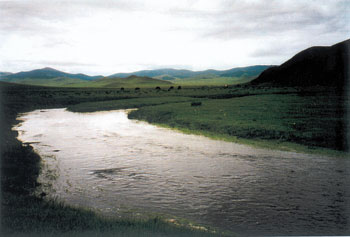 >> Mark Harris, River in Nothern Mongolia
>> Mark Harris, River in Nothern Mongolia
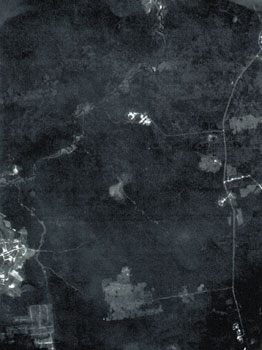 >> George Chaikin, satellite imaging of the gilf and central asia, 2001
>> George Chaikin, satellite imaging of the gilf and central asia, 2001
AFGHANISTAN WATERSHED & THE PIPELINES
An El Queda network can mimic the power structure now in place (witness the attacks from within borders), but it cannot replace it – not if the power base of the planet continues to be petroleum.
The map pictured above shows the battle for control of Caspian/Aral Sea exports. The two markets to be served are Europe (chiefly in the East) and, much bigger, East and South Asia.
The latter holds about two thirds of the world’s population and most of the world’s new boom potential. Whoever controls supply from the new petroleum fields in Central Asia, along with those relatively nearby fields of North Slope Alaska, will take a leading role in the economic development of East and South Asia.
The blue lines are the chiefly-ocean routes of the maritime powers: the US; UK; Netherlands and France. The land segments from the Caspian/Aral pass through Georgia and eastern Turkey, on the European side, and through Afghanistan and south west Pakistan (Baluchistan) on the east Asian side. This latter route, through Afghanistan is now the centre of battle.
The red lines are the chiefly-land routes of the traditionally inland powers: Russia; Italy; Germany; China and, in a competitive trans-Afghanistan bid, an Argentinian pipeline company, Bridas, with evident German and Italian links. Russia and China have long been talking of building a trans-Asian petroleum empire. Engineering would come from Germany and Italy. In line with this, German Foreign Minister Joschka Fischer has visited Central Asian Republic capitals, and then China, in an attempt to realise his country’s age-old pan-Eurasian fantasies. Ironically, with petroleum, those ambitions are not so green.
A pipeline route from the Caspian Sea across the Black Sea to Trieste has been blocked by the Novi Sad bombings. A similar route to Vlore in Albania has been blocked by unrest and troop presence in Macedonia. Another pipeline route has been blocked by the war in Chechnya, and a far-east extension of the much-vaunted ‘fuel for growth’ route to China is blocked by the division of Korea into North and South. Tankers supplying East Asia could yet face demands from angry Muslims in the Straits of Malacca, or from China insisting that the entire South China Sea, with oil-rich islands in the centre, belongs to them. The likelihood of reaching an impasse is very great. We cannot foresee now how these blue or red supply lines will work.
Meantime, given the prospect of global warming, of east or south Asian cities choking on local pollution, even of the floor of the Caspian Sea erupting if destabilised by too much drilling, let alone the task of pacifying the oil-rich region’s populace, it appears safer to go beyond mineral fuels towards energy technologies that rely on daily natural processes, not stored up reserves.
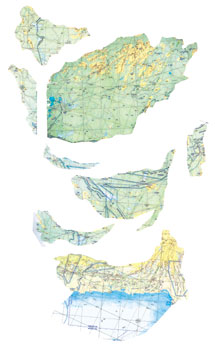 >> Peter Fend, saltwater basins of Afghanistan
>> Peter Fend, saltwater basins of Afghanistan
WHAT IS TO BE DONE? [First action in Exeter]
To go beyond the present impasse, the world must go beyond petroleum. It should also go beyond using reserves of other mineral fuels like coal or uranium, towards daily natural processes. These processes include: sunlight; tides; waves; the Earth’s sub-crust heat; river flows and – most fecund – the capture of solar energy by plants, especially saltwater plants. The ocean, with its algae, is the source of the new petroleum.
There is the big ocean, the world ocean, and there are smaller oceans within continents. The first is comprised of the Atlantic, Arctic, Indian and Pacific Oceans. The latter, now at the heart of conflict, are oceans confined within land, like the Caspian Sea, the Aral Sea and the Hamuns (playas) in most of Iran, Afghanistan, western China, even parts of Turkey. Every one of these oceans could be a source of hydrocarbon wealth – not derived from fossil fuel but solar energy.
In Exeter, UK, (where the Meteorological Office will be re-locating in 2003), under the banner of the Ocean Earth Development Corporation, artists and scientists are demonstrating that with simple fouling rigs in seawater one can collect and harvest marine algae enough to start producing fuel-grade methane gas. Over the summer, at Spacex, Ocean Earth’s Sea Change project started with an exploration of the local relation of the Exe estuary to Lyme Bay, extrapolating out to explore the sea areas of the British Isles and their relations with the European land-mass, the Continental Shelf, then the North Atlantic/Arctic ocean basin and ultimately the whole world ocean.
The project presented satellite imaging, maps, films and earth models, including a special contribution by Dennis Oppenheim. It also included a prototype for a locally-based renewable system of energy production based upon the collection of biomass (kelp) in the Lyme Bay basin cultivated on a submersible rig at the mouth of the Exe estuary, allowing the sediment that forms where the river meets the English Channel to yield large amounts of methane.
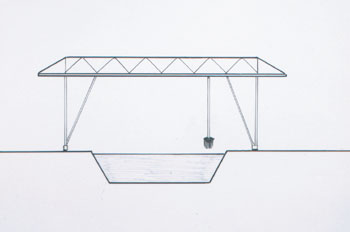

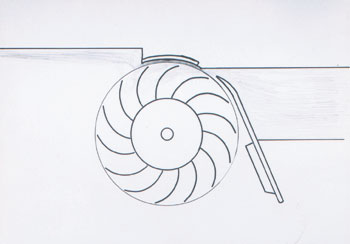
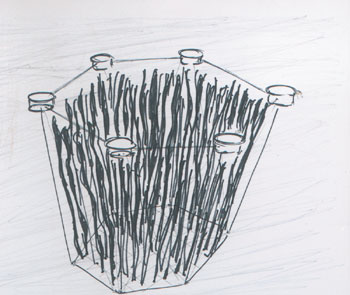 >> Peter Fend, drawings of four renewable clean-energy technologies being developed by Ocean Earth
>> Peter Fend, drawings of four renewable clean-energy technologies being developed by Ocean Earth
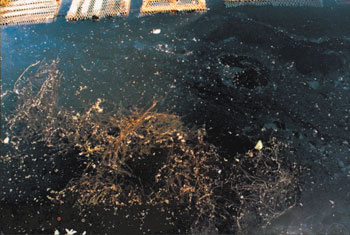
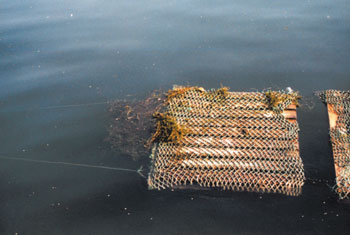
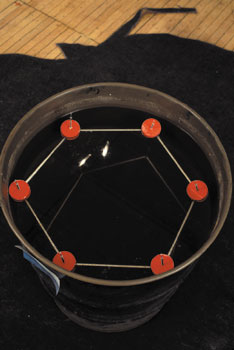
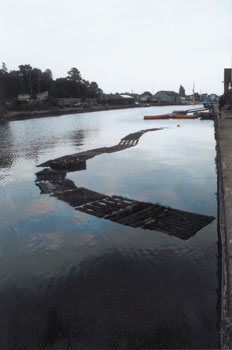 >> Steve Hughes, prototype algae rig moored in Exeter Canal Basin
>> Steve Hughes, prototype algae rig moored in Exeter Canal Basin
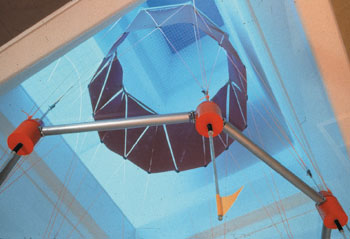 >> Peter Fend, 1:20 scale model of Giant Algae System Clean Air Rig
>> Peter Fend, 1:20 scale model of Giant Algae System Clean Air Rig
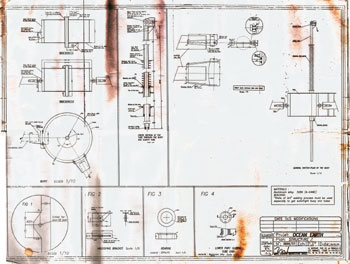 >> Plans for macrocystis algae rig
>> Plans for macrocystis algae rig
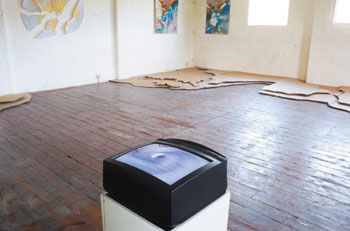 >> Sea Change installation, showing the exchange between the Arctic and North Atlantic basins, including Vortex Funnel video-work by Dennis Oppenheim, satellite imaging by Samantha Lavender and George Chaikin, and cardboard models of land and shelf configurations by Peter Fend
>> Sea Change installation, showing the exchange between the Arctic and North Atlantic basins, including Vortex Funnel video-work by Dennis Oppenheim, satellite imaging by Samantha Lavender and George Chaikin, and cardboard models of land and shelf configurations by Peter Fend
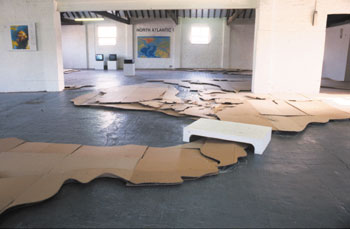 >> Sea change installation, showing the Met Office 'sea areas' expanded to include all the land and river watersheds that feed into the defined areas ( The effect of this re-definition is that an area such as 'Thames' is seen to include not onlythe outflow from the Rhine and Maas rivers, the biggest freshwater influence on the Continental Shelf by far. This includes run-off from the most industrialized parts of Europe, extending deep into the Alps.) by Peter Fend
>> Sea change installation, showing the Met Office 'sea areas' expanded to include all the land and river watersheds that feed into the defined areas ( The effect of this re-definition is that an area such as 'Thames' is seen to include not onlythe outflow from the Rhine and Maas rivers, the biggest freshwater influence on the Continental Shelf by far. This includes run-off from the most industrialized parts of Europe, extending deep into the Alps.) by Peter Fend
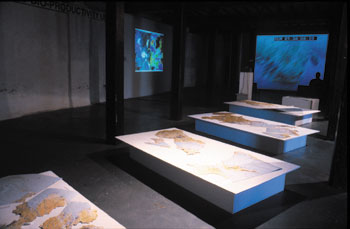 >> Sea Change installation, showing an earth model of the Exe river watershedand its relation to Lyme Bay by Peter Fend.
>> Sea Change installation, showing an earth model of the Exe river watershedand its relation to Lyme Bay by Peter Fend.
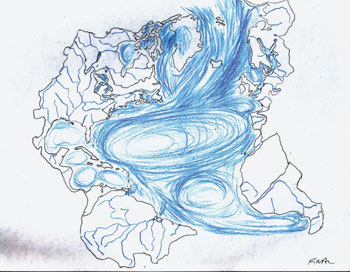 >> Drawing by Peter Fend of the 'Ocen Earth' map of the world oceans, centred around Antarctica, using Steirischer Herbst projection, 1998
>> Drawing by Peter Fend of the 'Ocen Earth' map of the world oceans, centred around Antarctica, using Steirischer Herbst projection, 1998
WATERSHEDS
A key principle, long espoused by Ocean Earth, is that continents do not exist. In nature, in the geophysical dynamic that is Earth, there are no “contained” lands. Rather there are collisions of upheaved sea floors, and there are sea floors which are more raised than others. If you try administering a combination of upraised sea floors, each draining in opposite directions, you end up trying to administer completely disparate systems. The world of the Mediterranean Sea, ecologically, oceanographically and culturally is vastly different from the world of the Baltic Sea.
Essentially Ocean Earth views the globe from the centre of the world ocean, the South Pole, with the three major outlying oceans, the Atlantic, Pacific and Indian Oceans, extending on out from Antarctica and the Southern Ocean. Exchange between North and South is primarily through the Atlantic corridor, driven by four main saltwater gyres that are fed by freshwater and silt from rivers like the Amazon, Mississippi, Congo, Niger, Plata, Rio Grande and the ice-cap of Greenland.
At a regional level, all land can be viewed as ultimately sloping down, or draining into a saltwater basin. The environmental conditions of the British Isles and Northern Europe, for example, are defined by the shallow waters of the Continental Shelf, with its own heightened mixing of fresh and salt waters, of run-off nutrients and, hence, of life-forms like phytoplankton. The Shelf receives its saltwaters and its weather, its incoming currents and clouds, from the Gulfstream, the course of which is ultimately determined by the collision of cold waters from the North with warmer waters from the South. As the waters of the Arctic are warming up, the Gulfstream is beginning to shift southwards, so threatening to radically alter the environmental conditions of Northern Europe.
Ocean Earth believes it can contribute to predictions of long-term climate change based upon the re-organization of geographical information according not to land masses or hemispheres, but to ocean basins. At issue is what changes in these circulatory patterns result from human actions, e.g. carbon emissions, deforestation, changes in river run-off, river dams, phytoplankton depletion in shelf / ocean waters, monoculture, desertification, etc. The assumption is that humanity has become by far the dominant influence on the physical environment, such that one can speak of the weather and associated events, like drought and flood, as ‘man-made’. To deal with this reality of human impact, Ocean Earth zeroes in on smaller regions, always defined as ocean or saltwater basins, and works with them comparatively, to assess the environmental health of the parallel locations.
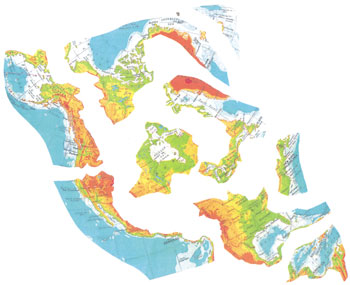
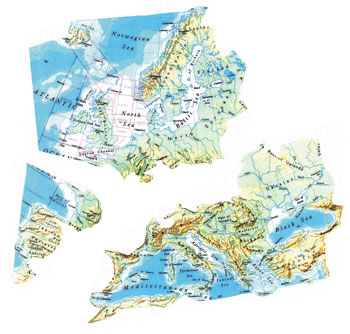
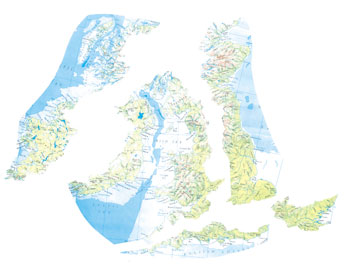 >> Peter Fend, watersheds of Western Europe,North America and Great Britain
>> Peter Fend, watersheds of Western Europe,North America and Great Britain
PROPOSED PROJECTS - NEVADA/PAKISTAN
Regarding the NEVADA project, which occurs in the little-ocean basin of Roach Lake, USA. Ocean Earth proposes to use an Oppenheim target in the desert image.
The sine qua non of life is Water.
On this planet, we happen to be exiled from the ocean. We depend for our well-being, for our survival, on precipitation and the subsequent downward flow of freshwater. To obtain freshwater (notwithstanding various probably-harmful artificial attempts, like desalinisation), we depend on WATER CYCLES, [the evapotranspiration from lowlands leading to rain or snowfall, or just fog, in the upper lands, with enough of this for flows downhill so that plants grow, yield oxygen and biomass, and so that we can consequently both respire and eat.]
[Any saltwater basin is a site in which the water cycle happens.]
The basin can be the entire Atlantic Ocean, or it can be an inland concavity with a salt lake at the centre and no drainage out. The latter condition, of an inland concavity, constitutes a miniature version of the oceanic planet. It’s a microcosm. Often, but not always, such small inland concavities become dry. That’s because they gradually fill up with alluvia, including salts and silts, and then the evaporation increases until there’s no more water, so that the water cycle stops. The basin becomes desertified. That is, it becomes dead.
Our aim in Nevada, at Roach Lake, is to install various meander and marsh earthworks upland, the pit and cone earthworks for aquifer absorption downland, near the dry lake beds, and brown-algae rigs in the saltwater bodies. In Roach Lake there are two ‘stock lakes’. These have fish. They could also have brown algae, which are conducive to fish. Both the fish and the algae could be harvested. Ideally, the algae would be the very-fast growing Macrocystis. One might well gouge the lakes deeply, down to 40 m depth, in order to prompt vast growth of Macrocystis. The harvesting should be massive. It should be twice weekly, say; it should be frequent and aggressive. Then the lakes become gradually empty of runoff, of the accumulated alluvia of before. Then the lakes can become more like the ocean and can expand, as the ocean would. All this leads to... evapotranspiration. All this, particularly if phytoplankton are present in good numbers, can lead to what some scientists poetically call ‘breathing’.
A direct policy context for this work is the Middle East. We have identified the parallel between the distressed basins of the Gulf of California and the Persian/Arabian Gulf.
Methods of restoring the water cycles in one basin could also be applied to the other basin. In the Financial Times, Nov 28, an editorial says ‘It is true that US policy towards Baghdad is in desperate need of new direction.’ Well? How about a parallel basin policy for the US-Mexico Gulf of California and the Persian Gulf? This could be practiced in more confined form in the now-desertified basins of south west Asia, along that Pipeline Corridor extending from the (also interior) basin of the Caspian Sea down to the Indian Ocean. Alongside the Indian Ocean, there is also the watershed, or slope, of south west Pakistan (Baluchistan). What if engineering practices, developed in the Roach Lake Basin, were applied as well to the Gulf of California/Persian Gulf, and to the Baluchistan slope into the Indian Ocean?
One vital caveat, however. The optimum type of algae to be used depends on many factors, a primary one being temperature. We would try using Macrocystis wherever it is allowed, i.e. where scientists deem it to be native, but in many cases we must use other saltwater algae. In the Indian Ocean coast by Baluchistan, the warmth of the water probably requires use of much smaller algae, like Gracilaria. However, across the way along the Oman Coast, where deep waters upwell upon collision with the coastal shelf, one could (we think) resort to Macrocystis culture. In the interior salt lakes, not only of Nevada but also of central and south west Asia, a continental condition exists, and temperatures vary radically over the course of each year. One could have Gracilaria saltwater (marine) algae (blue-green) culture during the hot summer, and then have Macrocystis or Laminaria algae culture (brown) during the winter. In Afghanistan, such an alternation of sea-plant regimes could be particularly appealing. The Afghans pride themselves on their excellent farming practices, including seasonal rotation and subterranean (aquifer) irrigation. We in the West should expect to learn from them as much as, with art practices of recent decades, we try to pass along – in our basins as well as theirs.
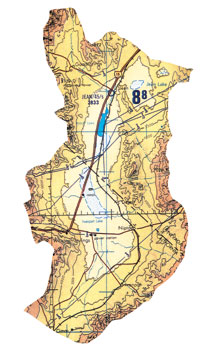 >> NEVADA project, which occurs in the little-ocean basin of Roach Lake, USA.
>> NEVADA project, which occurs in the little-ocean basin of Roach Lake, USA.
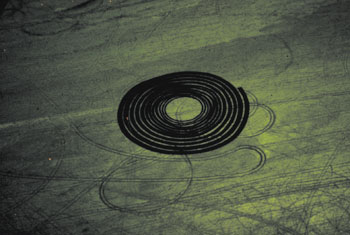 >> Dennis Oppenheim, Devils Hole 1974
>> Dennis Oppenheim, Devils Hole 1974
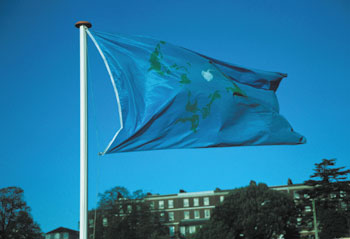 >> Flag of the Ocean Earth map, at Spacex 2
>> Flag of the Ocean Earth map, at Spacex 2
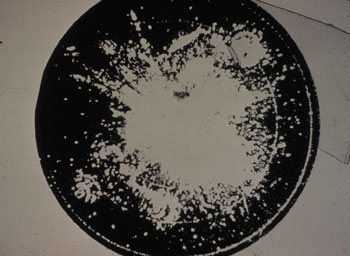
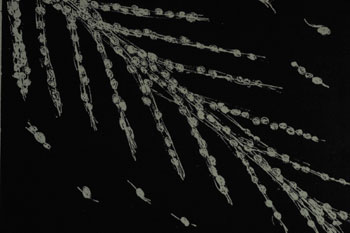 >> Sea Wiffs satellite imaging by Samantha Lavender (Institute of MArine Studies), showingsediment and algal blooms around the British Isles on 18 May 2001
>> Sea Wiffs satellite imaging by Samantha Lavender (Institute of MArine Studies), showingsediment and algal blooms around the British Isles on 18 May 2001
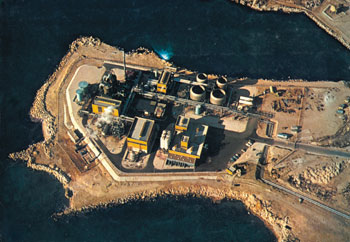
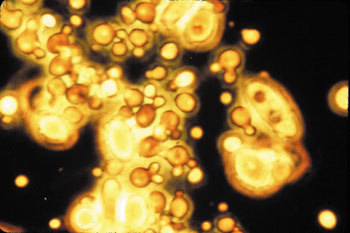
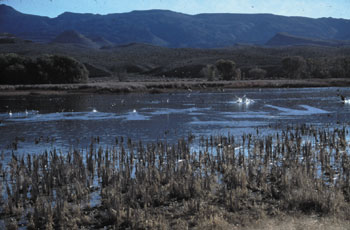
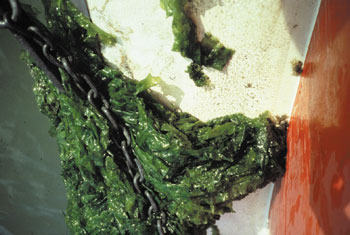
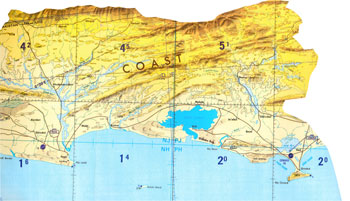 >> The images above are meant to show how an example OEDC algae operation could be put into operation on the coast of Pakistan.
>> The images above are meant to show how an example OEDC algae operation could be put into operation on the coast of Pakistan.
Peter Fend <fend AT ocean-earth.com>Born 1950 – grew up wanting to be either an architect/urbanist or an adventurer in geopolitics. Now he thinks he does both: he aims to make history, not art history, with art. An important goal, achievable through teamwork, is to get into the newspaper, as news, not as part of the arts section
Many thanks to Tom Trevor, director of the Spacex Gallery in Exeter, for his kind help and support.
Mute Books Orders
For Mute Books distribution contact Anagram Books
contact@anagrambooks.com
For online purchases visit anagrambooks.com


